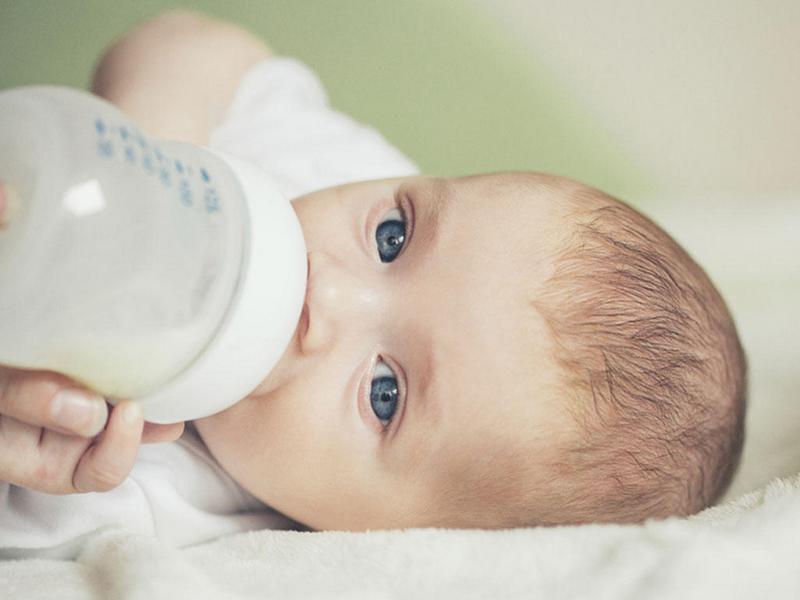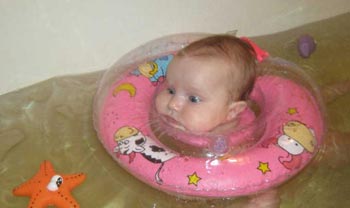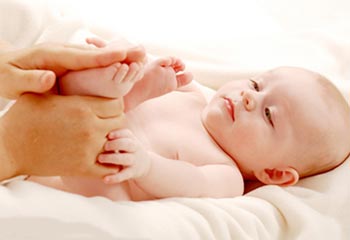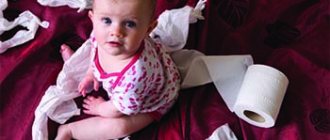Approximate daily routine for a 3 month old baby
The three-month-old baby becomes calmer than in previous months, which pleases the parents. He practically does not confuse day and night, and wakes up less often at night. By this age of the baby, the mother already has time to understand how important it is to observe the daily routine by the hour and stick to it. Ignoring sleep standards and not following a meal schedule will not work - in this case, sooner or later, alarming consequences may occur in the form of whims, overexcitement of the child and deterioration of the baby’s health.
Breastfed children's regimen
Each mother can make certain adjustments to the selected schedule by the hour, taking into account the individual characteristics of her child and caring for him. But it is very important to follow the sequence of actions of the regime, as well as the duration of the procedures, in order to develop the baby’s habit of waking up and eating at the same time.
| Time | Regime processes |
| 6.30 – 7.00 | Waking up, feeding, changing diaper |
| 7.00 – 7.30 | Light gymnastics, communication with mom |
| 7.30 – 8.00 | Air baths, morning massage |
| 8.00 – 9.00 | First nap |
| 9.00 – 9.40 | Waking up, feeding |
| 9.40 – 11.30 | Wakefulness, play time, communication with mother |
| 11.30 – 12.30 | Walk in the fresh air, second nap |
| 12.30 – 14.00 | Feeding, air baths, massage |
| 14.00 – 15.00 | Third nap |
| 15.00 – 17.00 | Wakefulness, play time, communication with mother |
| 17.00 – 18.30 | Walk in the fresh air, first evening sleep |
| 18.30 – 20.30 | Feeding, quiet games, evening bathing |
| 20.30 – 21.30 | Communication with mom, getting ready for bed, putting her to bed |
| 21.30 – 22.00 | Feeding |
| 22.00 – 00.00 | Second evening sleep |
| 00.00 – 00.30 | Feeding |
| 00.30 – 6.30 | Night sleep |
Regimen of babies on artificial and mixed feeding
With alternative types of feeding, the baby may have longer intervals between meals. This is due to the fact that the mixture takes longer to digest, and the child’s feeling of hunger comes later on average by 1 hour than in children on breastfeeding.
A healthy baby on artificial and mixed feeding should sleep calmly and soundly at any time of the day.
If the baby not only does not sleep, but also often cries, then the mother should suspect something is wrong and seek advice from a pediatrician. Important! Although 3 months is precisely the period when the baby’s intestinal colic goes away and the teeth have not yet begun to cut, there may be many reasons for concern in the baby.
3 month old baby's daily routine
The famous pediatrician Komarovsky also advocates that even such a small child can already be accustomed to a certain regime. However, he says that there is no need to follow the routine every minute. At this age, the daily routine is, rather, accustoming the little man to daily rituals that are repeated day after day.
In addition, you do not need to do everything exactly as indicated in various schedule options on the Internet. These are just examples. You must create your own daily routine that will be convenient for both the baby and other family members.
Now we will look at an approximate daily routine that a 3-month-old baby may have, whether breastfed or bottle-fed.
Breastfed
A baby's daily routine should contain everything necessary for its development. In this case, it is necessary to accustom not only to the sequence of procedures and their approximate time, but also to their duration.
The daily routine for a child on breastfeeding looks something like this:
| 7.00 | Waking up, feeding, exercise, games |
| 9.00 | Dream |
| 10.30 | Feeding, games |
| 12.00 | Walk and sleep |
| 14.30 | Feeding |
| 15.00 | Games, communication, air baths |
| 17.00 | Walk and sleep |
| 18.30 | Feeding and playing |
| 20.00 | Dream |
| 21.30 | Feeding, bathing, playing |
| 23.00 | Feeding |
| 23.30 | Dream |
Feed your baby when he wants to eat. It is absolutely not necessary to adhere to the presented schedule and keep your baby hungry.

On artificial and mixed feeding
The approximate daily routine of a 3-month-old bottle-fed child is not much different from the daily routine for infants. The only thing is that the child’s feeding regimen, or more precisely, the time intervals between formula intakes, are longer than for children of the same age who receive natural nutrition. Typically, formula-fed children begin to want to eat an hour later. This is due to the fact that it takes longer for the baby to digest the formula.
The same applies to children who are mixed-fed. True, in order to more or less accurately adhere to the daily regimen, you will need to indicate when you are formula-feeding and when you will breastfeed, since the breaks between meals will depend on this.
Children who are bottle-fed or mixed-fed usually sleep peacefully and soundly.
If the baby has problems sleeping and cries quite often, then parents should consult a pediatrician, as this may be caused by certain health problems.

Sleep of a 3 month old baby
A three-month-old baby sleeps at least 15-16 hours a day. Of these, about 10 hours are spent sleeping at night, and the remaining 6 hours are spent sleeping during the day. After 12 weeks of life, sleep duration undergoes changes. The baby begins to sleep less during the day, spending more time awake. By six months of life, the duration of daily sleep will be reduced to 14 hours.
Baby's sleep at 3 months (video):
Basic sleep standards for a three-month-old baby
| Night sleep | 10 hours |
| Daytime nap | 5 o'clock |
| Time to stay awake | 9 o'clock |
| Time to sleep per day | 15 hours |
Basic rules for a comfortable baby's sleep
- The air temperature in the room where the child sleeps should be 18-22 degrees. An influx of fresh air will help the baby fall asleep faster, so it is advisable to ventilate the room before rocking. Keep an eye on air humidity, especially during the heating season. A compact humidifier or a wet towel that needs to be hung indoors will help maintain optimal humidity.
- Sometimes healthy, sound sleep can be interfered with by an unsatisfied sucking reflex. When putting your baby to bed, you can give him a pacifier, and he will soon fall asleep. If the baby does not recognize the pacifier, then you can lull the baby by rocking him in your arms or stroking his back. Breastfed babies usually get their mother's breasts to help them fall asleep.
- It is better to place a crib for a three-month-old baby in the bright part of the room, but no closer than a meter from the windows and radiator. Do not place soft toys or other objects in your child's bed that he or she may bury his or her face in while sleeping.
- Regardless of the time of year, carry out daily wet cleaning in your child’s nursery. If your sleeping room is cool, avoid using heaters with open coils or models with fans. They are unsafe and burn oxygen, which will affect the baby's quality of sleep. Give preference to convection heaters.
What can influence the strength and duration of sleep?
| Mom's habits | If the mother is used to going to bed late and getting up early, then the child will unconsciously inherit this rhythm. Although this is not physiological. The optimal time for putting a child to bed at night is from 8 to 10 pm, this is the only way to keep the entire daytime routine at the right level. |
| Natural biorhythms | The sleep pattern of three-month-old infants is also associated with the length of daylight hours. It has been noticed that children in spring and summer wake up an hour or two earlier than in autumn and winter. |
| Ecological background | In the largest cities with high populations, due to inhalation of polluted air and lack of oxygen, babies sleep worse than their peers living in cleaner and more prosperous areas. |
Baby's sleep schedule at 3 months
If an adult needs to spend about 8 hours in bed for proper rest, then a baby needs to sleep 16.5-17 hours a day. Each daytime nap lasts about an hour and a half on average. If the mother has correctly chosen her own nutrition during breastfeeding, then the baby is not bothered by the tummy, and he rests calmly 3-4 times a day. Night rest lasts longer: 10-11 hours.
If a child falls asleep briefly during the day (an hour or less), then he may not be spending enough energy while awake. Try to spend this time more actively: do massages, gymnastics, show your baby different objects and name them, let's touch different surfaces. Having active time filled with different experiences and activities throughout the day will help you fall asleep well.
As for the process of falling asleep itself, infants, as a rule, fall asleep during the feeding process itself. Then the fallen asleep little one can be carefully transferred to the crib. A pacifier helps an artificial baby satisfy its sucking reflex.
Create conditions for good rest:
- ventilate the room so that there is enough fresh air in the room;
- monitor the humidity: wipe the floor every day, turn on a humidifier or hang a damp towel in the room;
- if the baby waves her arms and wakes herself up, then use a loose swaddle to limit movements during sleep;
- provide a calm environment, but do not maintain complete silence, as in this case the child will wake up from the slightest rustle. Of course, a loud TV will not help you sleep better, but soft household sounds will create a kind of soothing background;
- some children like calm, quiet music as a background;
- The same bedtime ritual helps prepare for rest: a lullaby, a poem, a fairy tale. This repeated action will put you in a “sleepy mood” and help you quickly adapt to your schedule.

Breastfeeding and bottle feeding at 3 months
Taking into account the regime, a baby whose mother practices breastfeeding should receive breast milk 6 times a day. The daily intake of breast milk for a 3 month old baby is about 800 ml per day.
At three months of age, on-demand feeding should be gradually replaced by a daily routine, keeping intervals between feedings of three hours. During this time, breast milk is completely digested by the body.
Important! If applied too frequently, as in the first months of life, the baby runs the risk of oversaturating its fragile stomach. This will lead to the body not being able to cope with a large volume of milk and reacting to it with an allergic reaction.
If the baby is fed formula milk, then it is necessary to take care of his diet as early as possible.
- At first, given that artificial feeding is established gradually, it is better to feed the child 7 times a day with an interval of three hours (it’s good if you can take a break of 6 hours at night). Mixed feeding also applies to this point, being equated to artificial feeding, and requires compliance with similar feeding intervals.
- When the mother notices that the baby does not have time to get hungry in three hours, you can try to increase the interval between feedings to 3.5 hours. After 4 months, you can try to gradually reach a 4-hour break.
Baby's daily routine at three months - mother's experience (video):
Hygiene procedures for a three-month old
Caring for an infant includes a mandatory ritual of the following procedures:
- morning wash,
- washing when changing a diaper;
- evening swimming.
Washing
Morning washing is carried out immediately after the baby wakes up. His face is wiped with a cotton pad soaked in warm water, cleaning the eyes, nose, cheeks and neck. Don't forget about the skin behind the ears - sometimes milk leaks there, and the skin there needs to be kept clean to prevent diaper rash.
Bathing
The bathing procedure is usually carried out in the evening, when the whole family is gathered. It is convenient to bathe a child using a baby bath with an inclination, or with a special hammock so that you can comfortably place the baby in it. It is also not forbidden to wash the baby in a large bathtub, putting a special circle around the child’s neck. It will allow the baby to float on the water without the help of mother’s hands, and be completely safe in the water.

Washing
When changing the diaper each time, you should wash the baby’s groin area under running water and thoroughly dry all the folds with a towel. Then you need to apply baby cream or powder under the new diaper. They will help avoid skin irritations or diaper rash on delicate skin.
Hygiene procedures
Hygiene procedures at 3 months include: washing, bathing, changing diapers. Washing and bathing at 3 months occurs every day. These actions, performed regularly, help the baby distinguish day from night.
Morning toilet necessarily includes the following actions:
- The eyes are washed with boiled water using cotton pads. A separate disk is taken for each eye;
- the nose is cleaned with cotton swabs from secretions and dry crusts;
- wipe the cheeks with discs soaked in water;
- wipe with water and blot all the folds on the body with a soft towel.

When changing diapers, you need to wash the baby under running water or dry thoroughly with napkins. Apply moisturizer or powder to clean skin. To prevent irritation, it is useful for the little one to lie down for some time without a diaper, taking air baths.
Such a procedure as nightly bathing usually brings a lot of pleasure to the whole family. You can use a special inflatable ring in the bathroom. It fits around your neck and helps keep your head above water. When agitated, soothing infusions of herbs (lavender, chamomile) are added to the water. The head is washed about once a week.
Gymnastics and massage at three months
Massage
Massage for children at three months is performed by the mother or a special massage therapist as prescribed by the doctor. At this age, restorative massage is often prescribed to young patients by neurologists to relieve muscle tone and prepare the spine for the acquisition of upcoming skills - rolling over, sitting, crawling.
- A massage is given to the baby after sleep. The child should be calm, in good spirits and well-fed.
- Touches should be soft, almost weightless. Using stroking circular movements of your fingers, you need to massage the palms, feet, legs, back and tummy of the baby.
- For a comfortable procedure, the hands of the adult performing the massage should be lubricated with baby oil during the process. During the massage, the child needs to remove the diaper and place him on the diaper.
- The massage time is 10-15 minutes. Massage is combined with air baths. The room should be warm enough so that the baby does not freeze.

Gymnastics
Gymnastics for a three-month-old baby mainly includes exercises for alternating flexion and extension of the limbs.
- An effective exercise is to spread the legs (knees) to the sides. It helps prevent hip dysplasia.
- The child needs to take the arms, gently lift them up, then spread them wide apart and finally cross them in front of the chest.
- After the procedure, be sure to place the child in a horizontal position lying on his stomach. If morning exercises bring pleasure to your child, you should devote 10-15 minutes to it every day.
Walking with a 3 month old baby
“Sun, air and water are our best friends!” It is these three faithful “comrades” that should surround the child as often as possible from the first days of life. It’s up to parents to organize daily walks for their child. With a three-month-old baby in a stroller, you can go for a walk in the courtyard of a city high-rise building, a square or a park nearby. In summer, the list of walking places is replenished with trips to the country house, to the forest, to the river, the sea, etc. What rules of conduct should be followed when walking with a baby at different times of the year? We have displayed them in a table for your convenience.
| When we walk | How we walk |
| Winter | Frost and snowfall are not a reason to refuse to walk outside. Winter sun exposure allows your baby's body to produce vitamin D, which is essential for healthy growth. In winter, during sudden cold weather, increase the walking time gradually - from 20-30 minutes to 1.5 hours twice a day. You can safely walk down to -10 degrees; babies tolerate this air temperature well. |
| Spring and autumn | In the off-season, it is better to choose the time for walking in the afternoon. It is quite often damp and windy outside in late autumn and early spring, so some of the morning walks can be replaced with “balcony” walks, or their duration can be reduced to half an hour. |
| Summer | During the warm season, it is advisable for the child to be in the fresh air as often as possible. If possible, take your baby for long walks for 2-3 hours twice a day. A baby in a stroller can be pampered with sun and air baths from 10 minutes to half an hour. But stay away from direct sunlight - the baby's delicate skin can burn, so cover your baby with a stroller hood or a canopy made of light fabric. |
Walking with your baby
A 3-month-old baby's daily routine must include at least one walk in the fresh air. You can walk with a small child in the yard of your house or in a park, if there is one nearby. If summer has already arrived, then you can take your baby with you to the dacha, the sea, the forest or a picnic. It is worth considering that depending on what time of year it is, there are certain rules for walking.
Walking with your baby in winter is just as important as in summer. Regardless of how cold it is outside or whether it is snowing, sun rays are very necessary for the baby to produce vitamin D in sufficient quantities. It is better to start winter walks with 20-30 minutes and gradually increase. However, you should not walk at temperatures below -10.
In autumn and spring it is better to walk in the evening. This is due to the fact that during this period of the year it is quite damp and windy, so it is better to take short walks in the morning.
In the summer, babies should walk outside as much as possible, and this also applies to a 3-month-old baby. If this is possible, then take the baby for a walk 2 times and walk for 4-6 hours a day. Just don’t expose your child to direct sunlight. His skin is still too tender and can burn.
Tips for creating a daily routine
- While observing your baby’s behavior, try to understand in what mode his body lives. This can be noticed by paying attention to the child’s activity when it is more pronounced - in the morning or in the evening. When thinking about your schedule by the hour, take these features into account.
- If you don’t know where exactly to start establishing a routine, start with feedings. Orderly meals have a lot of benefits. Having gotten used to eating at the same time, the body begins to produce gastric juice and saliva, due to which milk is well absorbed and brings satiety to the baby, as well as good health.
- For some babies, it turns out that they themselves develop their own sleep, wakefulness and feeding patterns thanks to their “internal clock”. Other children may, on the contrary, take a long time to get used to the new daily routine, confuse day and night and live in complete chaos. A stable framework and predictability of the regime can be established for more than one month, up to a year. Your task is to be patient parents, everything has its time.










